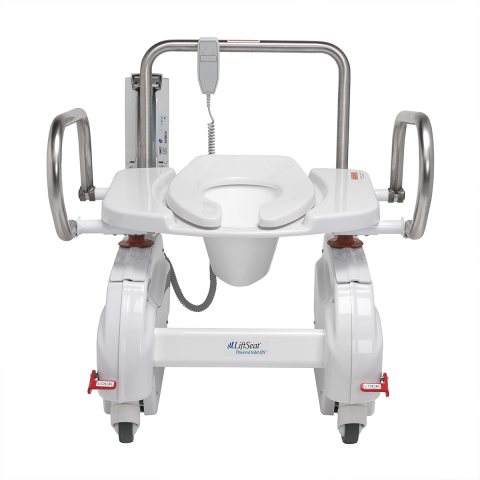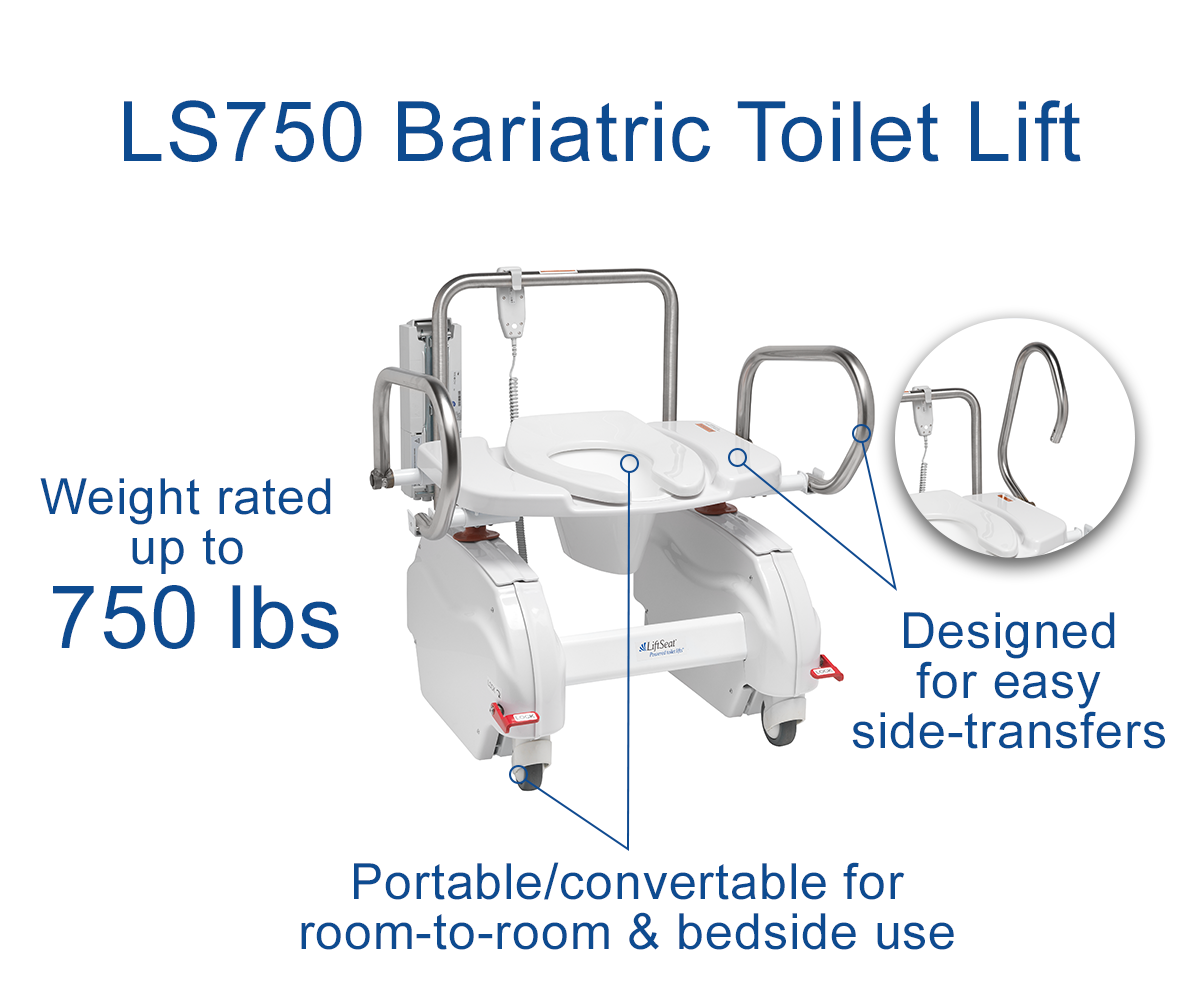LiftSeat Power Toilet Lifts: A Vital Tool for Bariatric Patient Care
10/08/2024
Caring for obese individuals in a healthcare setting comes with unique challenges, and not all healthcare facilities are adequately equipped to meet these needs. Many healthcare providers report facing challenges with bariatric care due to a lack of equipment, staff, and training.1
Bariatric bathroom safety, especially as it relates to toilet use, poses a particular point of concern. Falls related to toileting are common in hospitalized individuals.2 Assisted transfers can help reduce falls, but when performed without proper equipment, they may increase injury risk to healthcare staff.
To minimize injury risk to both bariatric patients and healthcare providers, bariatric toileting aids should be considered. Power toilet lifts offer an excellent way to facilitate safe toilet use while supporting patient privacy and dignity.
Reducing Healthcare Provider Injuries Related to Bariatric Care
Obesity rates are increasing worldwide. Over a span of 22 years, the number of adults with obesity doubled, with 1 in 8 people being considered obese as of 2022.3 Data also indicates that obese individuals are more likely to utilize healthcare resources,4 meaning healthcare providers regularly provide care to bariatric patients.
Despite the regularity of bariatric patient care, many healthcare providers don’t have access to the resources they need to safely care for these individuals, resulting in disproportionately high injury rates. One study looking at the impacts of moving obese patients found that nearly 30% of injuries due to patient handling were related to bariatric patients, even though bariatric patients made up just 10% of the total included patient population.5
In a report prepared by OSHA analyzing approaches to reducing musculoskeletal injuries within the healthcare industry, getting on and off the toilet was identified as a “high-risk activity”.6 The report also found that introducing training and assistive equipment helped significantly reduce injury rates.
Toileting aids such as grab bars and raised toilet seats help make toilet transfers easier, but they often still require staff assistance. Power toilet lifts, on the other hand, support the complete sit-to-stand motion, often eliminating the need for staff-assisted lifting and thus minimizing staff injuries related to toilet transfers.
Supporting Bariatric Patients’ Needs & Dignity
Lack of proper bariatric tools and training negatively affects not only healthcare staff but patients as well. When a facility is not equipped to safely move bariatric patients, it leads to a poor patient experience, both physically and psychologically.
A meta-analysis looking at the prevalence of falls in older obese individuals found that “obesity increases the risk of falls and multiple falls in people aged 60 years and older.”7 While this study was not limited to hospitalized individuals, and did not find any association between obesity and an increase in fall-related injuries, falls within the overall patient population remain a leading cause of injury in healthcare settings.8
In addition to the risk of physical injury, bariatric patients may also experience emotional harm related to a healthcare facility’s inability to accommodate their needs. In an article looking at the treatment of morbidly obese patients, the authors write, “Caring for the bariatric patient can be challenging and healthcare professionals need education, proper equipment, and established protocols to enable them to give the best possible dignified care to patients with obesity. It is true that the healthcare professional may have a personal bias regarding obesity and concerns about receiving injuries while providing care to the bariatric patient. This is why it is essential for the healthcare setting to have systems in place to identify and meet the needs of bariatric patients.”9
Power toilet lifts, like other bariatric equipment, can help facilitate safer bariatric patient handling to reduce falls. They can also support greater patient dignity and satisfaction by allowing for greater independence using the toilet.

Maximizing Safe Patient Handling with LiftSeat Bariatric Toileting Support
LiftSeat (a leading manufacturer of in-hospital and at-home toilet lifts), offers a power toilet lift designed exclusively to support bariatric care. The LS750 Toilet Lift combines LiftSeat’s proprietary LiftTek™ Core Assistive Technology with bedside-to-bathroom flexibility to deliver the most advanced toilet transfer solution available for safe bariatric patient handling and fall prevention.
LS750 Toilet Lift offers several features that make it ideal for bariatric care:
Bariatric Weight Rated Up to 750 lbs
The LS750 Toilet Lift can accommodate individuals up to 750 pounds (100lbs more than similar bariatric power toilet lift products)
Portable for Room-to-Room or Bedside Use
Unlike some bariatric equipment that must be installed from the ceiling, the LS750 is portable, so it can be moved from room to room and easily converted for bedside use.
Designed to Accommodate Side Transfers
Flip-up sidebars and a flat transfer seat make side transfers easier. The transfer seat is also flush with the seating platform base for easy cleaning.
Made in the USA
LiftSeat is the trusted choice of the U.S. Department of Veterans Affairs. All LiftSeat toilet lifts are made in the USA in accordance with ISO standards for quality and safety.
Minimal Investment for Maximum Impact
Compared to the cost of patient and staff injuries, the cost of implementing LiftSeat LS750 Power Toilet Lifts into a bariatric care program is minimal. A healthcare facility can invest in multiple power toilet lifts for a fraction of the cost of a single fall.10
In addition to the financial benefit, a power toilet lift supports a safer and more inclusive healthcare environment, empowering healthcare providers to care for bariatric patients with the utmost proficiency and dignity – making it a vital tool for modern bariatric care.
To learn more about the LS750, and LiftSeat’s other healthcare products, click here: https://www.liftseat.com/healthcare-products
References:
- Dockrell, S., & Hurley, G. (2021). Moving and handling care of bariatric patients: a survey of clinical nurse managers. Journal of research in nursing : JRN, 26(3), 194–204. https://doi.org/10.1177/1744987120970623
- Rose, G., Decalf, V., Everaert, K., & Bower, W. F. (2020). Toileting-related falls at night in hospitalised patients: The role of nocturia. Australasian journal on ageing, 39(1), e70–e76. https://doi.org/10.1111/ajag.12696
- World Health Organization. (2024, March 1). Obesity and overweight. World Health Organization. https://www.who.int/news-room/fact-sheets/detail/obesity-and-overweight
- Nørtoft, E., Chubb, B., & Borglykke, A. (2017). Obesity and healthcare resource utilization: comparative results from the UK and the USA. Obesity science & practice, 4(1), 41–45. https://doi.org/10.1002/osp4.148
- Randall, S. B., Pories, W. J., Pearson, A., & Drake, D. J. (2009). Expanded Occupational Safety and Health Administration 300 log as metric for bariatric patient-handling staff injuries. Surgery for obesity and related diseases : official journal of the American Society for Bariatric Surgery, 5(4), 463–468. https://doi.org/10.1016/j.soard.2009.01.002
- Fragala, G. (n.d.). (rep.). Successful Approaches to Reducing Occupational Musculoskeletal Disorders Within The Healthcare Industry. United Stated Department of Labor Occupational Safety and Health Administration Office of Training and Education. Retrieved October 4, 2024, from https://www.osha.gov/sites/default/files/training-library_successapproach_hc.pdf
- G R Neri, S., S Oliveira, J., B Dario, A., M Lima, R., & Tiedemann, A. (2020). Does Obesity Increase the Risk and Severity of Falls in People Aged 60 Years and Older? A Systematic Review and Meta-analysis of Observational Studies. The journals of gerontology. Series A, Biological sciences and medical sciences, 75(5), 952–960. https://doi.org/10.1093/gerona/glz272
- LeLaurin, J. H., & Shorr, R. I. (2019). Preventing Falls in Hospitalized Patients: State of the Science. Clinics in geriatric medicine, 35(2), 273–283. https://doi.org/10.1016/j.cger.2019.01.007
- Thomas, S. A., & Lee-Fong, M. (2010). Maintaining Dignity of Patients with Morbid Obesity in the Hospital Setting. Bariatric Times, 8(4), 20–25. https://bariatrictimes.com/maintaining-dignity-of-patients-with-morbid-obesity-in-the-hospital-setting/
- Dykes, P. C., Curtin-Bowen, M., Lipsitz, S., Franz, C., Adelman, J., Adkison, L., Bogaisky, M., Carroll, D., Carter, E., Herlihy, L., Lindros, M. E., Ryan, V., Scanlan, M., Walsh, M. A., Wien, M., & Bates, D. W. (2023). Cost of Inpatient Falls and Cost-Benefit Analysis of Implementation of an Evidence-Based Fall Prevention Program. JAMA health forum, 4(1), e225125. https://doi.org/10.1001/jamahealthforum.2022.5125
This content is not intended to be a substitute for professional medical advice, diagnosis, or treatment. Always seek the advice of your physician or other qualified health provider with any questions you may have regarding a medical condition.